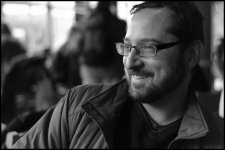Benjamin Marks
Veteran
Here is an available-light portrait from this weekend with the RD-1 set at 400 and the 50 Summilux at f2 or so. Shot in Epson's B&W mode and converted from RAW with Epson's RAW converter and then Photoshopped from a 16-bit RGB TIFF to 8-bit grayscale jpg for sending and posting. I print from the 16-bit image and the 6x9 inch print looks very nice indeed. I may try to go larger with this image (9x12) as a gift.
Comments welcome, of course.
Ben Marks
Comments welcome, of course.
Ben Marks


